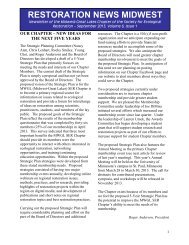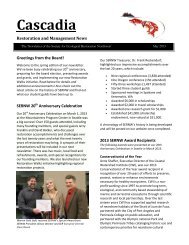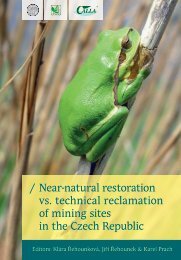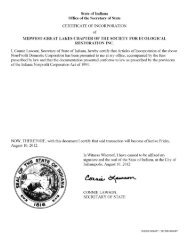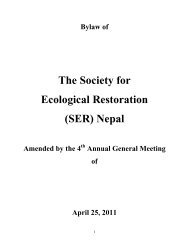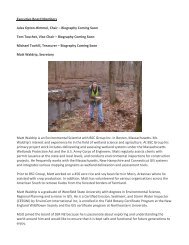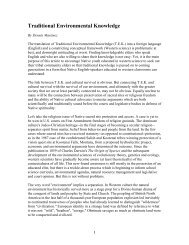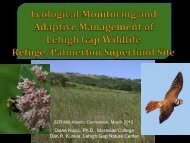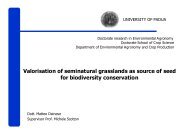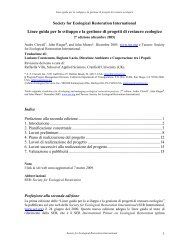THE WORLD CONFERENCE ON ECOLOGICAL RESTORATION
A Global Challenge - Society for Ecological Restoration
A Global Challenge - Society for Ecological Restoration
Create successful ePaper yourself
Turn your PDF publications into a flip-book with our unique Google optimized e-Paper software.
2005 The World Conference on Ecological Restoration 41<br />
tially, we need to overcome the ideology that our interaction with nature is simply assisting or facilitating<br />
the recovery of natural processes. Our restoration management adds to extant natural processes and<br />
thus, we inadvertently become an additional player in the system structure. Restoration models need to<br />
recognise the trophic roles of our participation in the natural system and the ecological consequences of<br />
our management actions on the other biotic and abiotic components. To this end, we may develop more<br />
accurate conceptual models and gain insight for improved ecological restoration practice.<br />
Keywords: Ecological restoration, ecology, people, assistance, interaction.<br />
Challenges and prospects for sustainable development and restoration in arid<br />
and semiarid areas.<br />
Burmil 1 S., Z. Naveh 2<br />
1 Department of Planning and Landscape Architecture, Clemson University, Clemson, SC 29631<br />
2 Technion, Haifa, Israel<br />
More than half of the earth's land surface is defined as arid and semi-arid, yet, their share in the global<br />
population and political power and economics is much smaller. Arid and semi-arid landscapes pose particular<br />
challenges as well as prospects for sustainable development and restoration. These areas share<br />
some common characteristics such as limited resources (e.g., water and productive soil) and high spatial<br />
and temporal variability in resources and conditions. While many of the characteristics can be individually<br />
found in other areas, their co-occurrence in arid and semi-arid areas can be defined to be unique.<br />
The recognition of the differences between arid and semi-arid landscapes is important for sustainable development.<br />
Sustainable development and restoration means wise use of resources for the benefit of present<br />
and future generations. Wise use also implies making the best use of existing local resources rather<br />
than wasting resources in efforts for large scale landscape transformations. The survival of healthy<br />
human communities in these areas depends also on preventing the rise in global temperature. Knowledge<br />
and understanding of the specific characteristics in these areas and adapting appropriate policies to<br />
enhance prospects rather than expensive landscape transformation efforts are critical. The challenge for<br />
sustainable development should also include empowering local communities, respect and protect their<br />
traditional ways of life and ensure their participation in the development. The differences between arid<br />
and semi-arid landscapes, the need for careful adaptations of policies and technologies as well as economic<br />
and cultural processes to the ecological processes, will be the focus of this paper.<br />
Keywords: arid and semi-arid areas, sustainable development, policies.<br />
Multiple scale assessment for planning the ecological restoration of the Middle<br />
Ebro floodplains<br />
Cabezas 1 A., F.A. Comín 1 , E. González 1 , B. Gallardo 1 , M. García 1 , J. Guerrero 2<br />
1 Instituto Pirenaico de Ecología-CSIC. Avda. Montañana 1005. Apdo. 202. 50080 Zaragoza. Spain<br />
2 Servicio Provincial Medio Ambiente. Dpto. Medio Ambiente-DGA. Pza. San Pedro Nolasco. Zaragoza. Spain<br />
The ecological restoration of ecosystems can be planned at different spatial scales depending on objectives<br />
and facilities for implementation. Small scales can be useful for patch or reach approaches. Assessment<br />
at large scale is necessary for planning restoration at large scale. A multiple scale assessment can<br />
be useful for planning the ecological restoration at large scale while providing the ecological requirements<br />
for efficient restoration at smaller scales. A landscape scale assessment of land-use changes of the Middle<br />
Ebro floodplain was done from comparison of aerial photographs different decades during the second<br />
half of the XXth century. Lack of longitudinal and transversal continuity of natural ecosystems is a common<br />
fact in all the floodplain. Also, accelerated silting of ox-bow lakes and loss of connectivity are observed.<br />
These changes are related with intensive use of the flood plain for agricultural purposes, establishment<br />
of dikes at the river shores, decrease of average river water flow and disrupted water regime of<br />
the river. Disrupted patterns of spatial plant distribution were observed in spectral transects of plant diversity<br />
measured in three different parts (proximal, central and distal) of different groves of the floodplain,<br />
and were related to human intervention (poplar plantations for wood production, controlled grazing<br />
by farm animals, and gravel extractions). Light extinction through the air column in woods and soil organic<br />
matter show differences at patch scale related to the physical structure of the woods and to the use<br />
of the soil for different purposes, respectively. Results from this multiple scale approach can be assembled<br />
to plan restoration at different spatial and temporal scales. In order to set up plans and goals for<br />
ecological restoration at large floodplain scale, water river flow and regime are key factors to be considered<br />
as increasing water connectivity is an essential characteristic to be recovered for efficient restoration<br />
at large scale. At grove scale, increasing connectivity and/or controlled plating, together physical design



